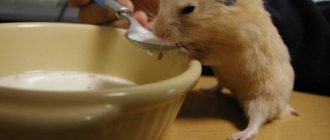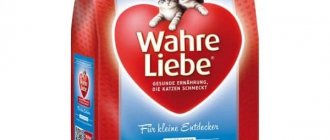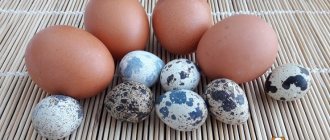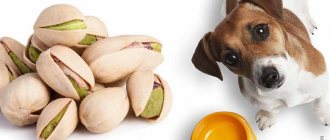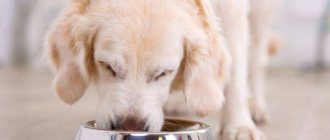Every owner has always wondered whether puppies and adult dogs can have milk. This is because this product contains large amounts of protein, calcium and other nutrients necessary for the functioning of the body. One of the pro arguments is that four-legged pets are mammals.
Despite these facts, you should not rush to conclusions and spoil your pets without understanding all the nuances. After all, we are exactly the same mammals as they are, and we still often choose a soy cappuccino or banana latte - but not because of a more pleasant taste, but in order to take care of our intestines.
Pros and cons of milk for dogs
The healing and nutritional properties of this product have a positive effect on the health of young dogs, but for adults they are not always beneficial. The mother feeds the puppy with milk, and it grows and develops better than with artificial nutrition. We conclude that the food is useful for the animal. However, the older the dog, the worse the nutrient fluid is absorbed. This is due to a decrease in production and the gradual disappearance of the enzyme responsible for processing milk. Despite this, it is possible and necessary to give fermented milk products to animals; they maintain the level of calcium in the body at a high level, strengthen bones and muscle tissue, and are a source of protein.
In adulthood, dogs are allowed to feed milk if there are indications from a doctor and in the absence of allergic reactions to the product. If puppies can pour fresh cow's or goat's milk into a bowl, then for older animals it is better to use kefir and cottage cheese.
There are cases when dogs love milk so much that they categorically do not want to give it up. In such situations, proceed as follows:
- Purchase a product with a minimum percentage of fat content.
- They use goat's milk diluted with water; it contains less lactose, which reduces the risk of allergies.
- Pet stores have special analogues that do not contain a dangerous component. You can buy them.
Regardless of the choice, such products are given to adult dogs no more than 2-3 times a week.
If dairy products are prescribed to animals by veterinarians, for example, when the development of young animals is delayed, it is better to cook porridge. Good weight gain was noted in puppies when fed semolina with milk. But the product should not be abused. If children are given high-calorie food daily, then it is contraindicated for adults.
Which milk is healthier?
We all know that milk is different. Products presented in large stores are often loaded with preservatives. It is best to purchase dairy products directly from manufacturers or from trusted companies.
Attention! Dairy products contain many useful substances: lactose, amino acids, fatty acids, various minerals (iodine, calcium, magnesium, potassium, zinc, etc.), as well as many vitamins.
The most acceptable for the dog's body are goat's and cow's milk with low fat content. You should not offer your pet more high-calorie options (camel, horse, etc.), since an organism unprepared for such food may experience a response in the form of spasms and intestinal problems.
Cases of lactose intolerance in dogs
Lactose intolerance is legendary; a high percentage of the world's population suffers from this type of allergy. Animals are no exception. Given the increase in negative reactions to the component, various conclusions are drawn. Some biologists suggest that the cause is a deteriorating environmental situation, others blame the antibiotics that are fed to animals and people.
Negative reactions to lactose in dogs are known and, unfortunately, they are not uncommon. Therefore, dairy should be introduced into your pet’s diet with extreme caution, just like for infants. Cook liquid porridge, preferably oatmeal or semolina, in milk and water in a 1:1 ratio and give it a little at a time, observing the animal’s reaction.
Manifestations of allergies can be different. Some dogs immediately experience bloating and intestinal upset, while others experience vomiting or other combined symptoms. Regardless of the reaction, you should consult a doctor to confirm the fact of intolerance to the component.
Sometimes skin itching and redness are signs of a lactose allergy. Some owners mistake this for seasonal shedding or a reaction to detergents. If any strange symptoms appear in your dog while introducing dairy products into the diet, you should contact your veterinarian.
Why raw milk can be dangerous
In the spring and summer, a goat's raw milk yield becomes a source of infection with tick-borne encephalitis. The disease is dangerous for people and dogs.
The virus enters the milk from the body of a goat bitten by a tick. The animal does not always have a full clinical picture. The disease occurs in a latent form. The goat becomes a carrier of a dangerous virus.
Raw cow milk is a potential source of brucellosis infection. The bacteria Brucella canis affects dogs. Causing serious infectious damage to the nervous system and brain.
Bacteria from an infected cow end up in the milk. Pathogenic flora remains active in the cow’s udder for up to 7–9 years.
Raw cow and goat milk is a potential source of salmonellosis. The bacterium enters the product from the animal's udder.
The milk production of cows and goats with mastitis is potentially dangerous. Since it contains large quantities of staphylococci and streptococci.
Milk and dairy products are a favorable environment for the development of intestinal infections. For example, dysentery.
Types of milk in dog nutrition
It turns out that the animal’s reaction depends on the type of milk. A cow, goat and horse have completely different compositions of nutrient fluid, and accordingly, their effect on the body. For dogs, as for people, it is recommended to choose a drink based on its benefits and ease of digestion.
Goat
The best product for feeding newborns and animals. Despite the somewhat specific taste and aroma, the product is extremely useful and is not inferior in properties to the mother’s. The maximum concentration of vitamins and microelements is perfectly absorbed and lays the foundation for the immune system. The amount of allergen is minimal, so negative perception of the product is reduced to zero. Despite this, milk is first given diluted to drink, then they begin to cook porridge with it, and only after that they are allowed to drink it in its pure form.
Cow
The most common type of product, widely used for feeding puppies. It contains a lot of lactose, but if there is no reaction, the animal can be fed cereals with milk for up to a year, gradually reducing its amount. Kefir and cottage cheese can be left in the animal’s diet forever, if the products are well tolerated.
Kobylye
The product is radically different from the above in composition. It is low in protein and fat, and lactose is present in excess. Veterinarians are categorically against the use of this product for feeding dogs. Kumis is made from milk; it is contraindicated for animals and children due to the presence of alcohols in the composition.
What and how to feed a small puppy
The dog has no milk, what should I feed the puppies? Buy a milk replacer for puppies. It is sold in many pet stores and veterinary pharmacies. The substitute must be diluted with water and fed according to the instructions.
What kind of milk should I feed newborn puppies if there is no substitute? It is better to give goat's milk to newborn puppies, if there is no other choice, you can give cow's milk. Prepare the mixture according to one of the recipes:
- Mix 2 eggs in 0.5 liters of farm cow's milk, after boiling.
- Add 1 egg to 100 ml of cow's milk, a drop of vitamins A and D.
Before giving the mixture to the baby, it must be warmed up. For feeding, buy a special bottle for puppies. A baby's pacifier will not work; in extreme cases, you can use a syringe or pipette after removing the needle.
Important: feeding a newborn puppy cow's milk is only a temporary option. How to replace milk for puppies? Be sure to find a bitch milk substitute, or better yet, a lactating dog. To do this, you can advertise in a local group of dog breeders on FB or VK.
How often to feed puppies
Always keep the phone number of a veterinarian at hand, who will tell you how and what to feed, how much milk to give the puppies. First, the dogs should be given food every two hours, then the time between feedings should be gradually increased:
- 1 week – after 2-3 hours;
- 2 week – every 4 hours;
- 3 week – after 4-5 hours;
- 1-2 months – 4 times a day.
From 3-4 weeks of age, dogs begin to be switched to semi-solid food. It is better to use commercial food designed specifically for newly weaned babies. If you haven’t found the product, can your puppy have porridge with milk, ask your veterinarian and check the recipe for the mixture.
Milk in the diet of a puppy and an adult dog
The differences between the diet of a puppy and an adult dog are known to all breeders. Dairy products also vary depending on the age, breed and body characteristics of the animal.
If for young dogs a high-calorie diet with a high content of calcium and protein is recommended, which has a positive effect on the formation of bone structure, then such a diet is dangerous for adult dogs.
A mature animal does not absorb vitamins and microelements contained in pure milk well. He can be given foods in the form of yogurt, cottage cheese, sour cream, kefir.
It is important to monitor the freshness of food. For example, kefir is useful only during the first day, cottage cheese a little longer.
Cheese is not recommended for dogs; you can sometimes treat them to a piece, but not more than once a month.
How to give correctly
Experts recommend using milk for puppies. From the age of 4-5 months, when the production of the lactase enzyme decreases, you need to switch your pet to fermented milk products. For example, replace with kefir.
Many animals themselves refuse to drink it when they reach adulthood. But, if your pet still loves milk, you should follow the rules:
- dilute with water;
- opt for goat milk;
- purchase lactose-free dairy products;
- add fermented milk products to your diet.
Owners often use milk to soak dry food for both puppies and adult dogs. This cannot be done! The food contains preservatives and pathogenic flora, which it only encourages to reproduce. This can lead to severe poisoning.
Dog diseases and milk
Dog owners often think that foods that are healthy for humans will benefit their pet - this is a misconception. For example, milk is used to treat colds in people, but if a dog is sick, this method of treatment may not only not help, but also harm.
Often, animals are given milk when they are poisoned, in the belief that it will help neutralize toxins. Indeed, this is possible if lead, mercury or other heavy metal salts enter the body. This is a rare case. In other cases of intoxication, milk will not only not help, but will also worsen the situation.
In case of poisoning, dogs are given light food that is easily digested and does not overload the gastrointestinal tract.
Sometimes with diarrhea and vomiting, breeders try to help the pet by feeding it milk. This only worsens the situation; enteritis requires a large amount of fluid and properly selected medications, which can only be prescribed by a veterinarian. Self-medication is never beneficial.
If dogs without allergic reactions regularly eat dairy products, other unpleasant consequences may occur. For example, urolithiasis. It develops against the background of a high concentration of calcium, which forms stones of various shapes and sizes. It is these diseases that are difficult to treat and can be fatal for the animal. Dairy products are especially dangerous for a number of breeds predisposed to KSD. These are dwarf poodles, Yorkies, Shih Tzus, and Bichon Frizes.
If we talk about the benefits and harms of milk for dogs, then during the period of illness it is an undesirable product, and during the lactation period in a lactating bitch it is recommended.
Regardless of whether a dog drinks milk just like that or as directed, it is necessary to carefully monitor its health. If there is the slightest disturbance in the gastrointestinal tract or allergic disorders, the product should be excluded and consult a doctor.
About the discussion
There are often quarrels between professional dog handlers and ordinary dog owners about whether the dog can be given milk. It is important to pay attention to what both sides rely on in their reasoning. Some people are guided by personal experience, traditions, and even simple human logic, while others are guided by the latest scientific research, surveys, and statistics.
Attention! Do not take a harsh position on this issue! In some situations, milk is simply necessary for the animal’s body, while in others, on the contrary, it is harmful.
Mr. Tail recommends: allowed and prohibited dairy products for dogs
Throughout its life, the dog should receive dairy products in small quantities; they carry essential substances and microelements. However, the use of dairy in the diet is permissible only in the absence of an allergy to lactose; if it is present and confirmed by a veterinarian, the product should be completely excluded.
Dogs are allowed fermented milk, with the exception of cheese, and whole milk during puppyhood.
Dogs that are allowed to include dairy in their diet should pay attention to the following list.
Cottage cheese
The product with a fat content of 6-9% is suitable for feeding adult dogs and children. Give it no more than 2-3 times a week in small quantities. Depending on the size of the dog, from one to six tablespoons. For young puppies, it is optimal to add one raw egg yolk to the mixture (only from a trusted supplier to avoid salmonella infection).
Yogurt
This fermented milk product is very healthy, but only if it is fresh, without preservatives and flavoring and aromatic additives. It is quite difficult to purchase pure yogurt, but if such a product is available, it has an excellent effect on the digestion of animals and qualitatively complements the daily diet. The amount of food depends on the size and does not exceed 100 grams for a large breed dog. Accordingly, little ones are given no more than a teaspoon per day.
Kefir
Animals are not big fans of kefir and there is no particular benefit to it. The minimum amount of calcium and lactic acid bacteria contained in it is present in yogurt and cottage cheese. Ryazhenka with a low fat content can be alternated with the above types of food to diversify the diet.
Milk (up to 4 months)
You need to start introducing milk into your diet at the age of 3 weeks. To get used to adult, solid food, crushed boiled yolk is added to the liquid. Every day the animal is given a little of the composition, gradually increasing the dosage. The diet includes milk for up to 4 months; from this period it is also necessary to gradually begin to reduce its amount, replacing it with fermented milk.
Is there an alternative
As already noted, if the animal does not receive milk, it can be replaced with premium feed or dietary supplements. However, this is usually very expensive. You can try other alternatives before purchasing them. We are talking about fermented milk products, in particular kefir or soft cheeses. They also contain a large amount of useful substances, including calcium, as well as amino acids and vitamins.
Milk standards in a dog's diet
The amount of whole milk varies depending on the age and weight of the pet.
A dog that has reached adulthood, that is, one year, is nominally considered an adult. Based on its weight, the dose of the product is prescribed, but the minimum portion is 100-125 ml. Puppies from 3 weeks to 2 months are allowed to give 30% less than the minimum, that is, 70-80 ml per day. For older children, the norm is increased to a glass, and upon reaching 4 months of age, the pet is transferred to kefir.
During the entire feeding period, the animal and its stool are monitored. If you have digestive problems, diarrhea or constipation, you should avoid milk.
Nursing mothers, provided there are no allergies, can receive up to 1 liter of milk per day from the last month of pregnancy until the last days of lactation. Naturally, for small breeds the dosage is much lower.
The optimal milk intake for your pet can be calculated by consulting a veterinarian, since it is individual for each animal.
How to replace milk
If you're worried that without milk you won't be getting enough nutrients for your animal's body, try buying a product that doesn't contain lactose.
Now stores offer a huge selection of plant-based milk substitutes. The main thing to remember is that not everything that is healthy and suitable for you will suit your pet. Almond or coconut milk may be too fatty and “heavy” for your dog’s digestive system. They often contain sweeteners that are harmful to the animal. Soy milk is strictly forbidden for dogs due to its high protein content. It can cause serious allergic reactions and harm your pet's health.
Fermented milk products can be a worthy replacement: low-fat cottage cheese, kefir, yogurt. They contain the necessary calcium and other trace elements, do not contain lactose or contain a negligible amount (traces) that cannot harm the dog.
You might be wondering if you can give your dog cheese.
First aid for signs of poisoning
Dogs can and should be fed any fermented milk products - this will help diversify and balance their diet. The main condition is that fermented milk should not contain sugar or artificial additives.
Don't forget about your pet's individual intolerances and taste preferences. To understand how a dog’s body reacts to a particular product - cottage cheese, sour cream or milk - you need to try introducing them into the daily diet. Observe whether your pet enjoys eating them and how he feels after eating certain dairy products. If you notice changes in your pet's behavior and health, such as: weakness, loss of appetite, stomach upset (diarrhea or constipation), dull coat, vomiting, convulsions, sudden loss of body weight, then you need to seek help as soon as possible to a specialist. All of the above symptoms may be the result of food poisoning from dairy products.
Is it worth giving?
The question of whether a dog should be given milk for humans arises because milk contains lactose. For its absorption, an enzyme is required, which is produced by each organism in its own way.
Lactose is a milk carbohydrate (from 2 to 8% by weight). This is a complex sugar. During digestion, it is broken down by an enzyme that is secreted in the small intestine - lactase, into glucose and galactose. These simple sugars are absorbed into the bloodstream.
The ability to produce the lactose enzyme in us and our pets is individual and unique. For some, it persists throughout their lives. But, most often, with age, less and less enzyme is produced, therefore, the ability to break down and absorb milk is lost.
IMPORTANT. In puppies of small breeds, the production of the enzyme for digesting lactose decreases already from 1.5 months, in puppies of large breeds - after 3 months.
Lactose and fat content in mammalian milk:
| Lactose | Fat | |
| doggystyle | 3,1% | 9,3% |
| Cow | 4,6% | 3,7% |
| Goat | 4,5% | 5,0% |
| Sheep | 4,8% | 7,2% |
| Kobylye | 6,4% | 1,8% |
Fermented milk products contain significantly less lactose:
| Curdled milk | 4,1% |
| Kefir | 4,1% |
| Yogurt | 3,5% |
| Sour cream | 3,2% |
| Cottage cheese | 1,8% |
The value of dairy products remains obvious: beneficial lactic bacteria, calcium, protein. All this can be included in your dog's diet in the form of fermented milk products that do not contain lactose.
How to provide first aid to a pet
- Eliminate the cause. The main thing is to remove from the body those products that could provoke poisoning. To do this, you need to induce vomiting: dissolve one tablespoon of salt in a glass of warm water and pour it into the dog’s mouth.
- Use adsorbents. For example, activated carbon, at the rate of one tablet per kg of animal weight. It will help remove toxins, gases and microorganisms from the intestines.
- Give more liquid. Before the veterinarian arrives, drink your pet with clean water; this is conveniently done with a pipette or syringe. It will reduce the content of toxins in the blood.
To summarize, it can be noted that dairy and fermented milk products can be both beneficial and harmful. However, the latter option is only possible if the animal has an individual intolerance to any elements or you have gone too far with the dosage.
Before introducing milk into your dog's diet, it is better to consult a veterinarian to avoid problems. We wish your four-legged friend good health!
What to do if things get bad?
If your dog starts vomiting or has diarrhea after drinking milk, you need to take the following steps :
- stop feeding the dog for 1-2 days;
- Provide her with enough clean water. If he doesn’t drink, force-feed from a spoon or pipette;
- After a fasting diet, you can include light foods in your diet: low-fat broths, beef, low-fat cottage cheese, well-cooked rice and rice concoctions.
If the symptoms disappear after 2-4 days, you can gradually switch your pet to a normal diet. If not, contact your veterinarian. Also, the dog should be taken to the vet immediately if:
- she had a fever;
- blood appeared in the stool;
- she does not want to eat or drink;
- She constantly vomits and has severe weakness.
Milk waste and its beneficial effects on the dog's body
The so-called “milk waste” - whey and buttermilk - is also useful to introduce into the dog’s diet to saturate the body with calcium. In addition, they contain a number of other useful elements: potassium, magnesium and phosphorus.
The great advantage of whey over other lacto-products is that it consists of 94% water, and the proportion of fat in it is only 0.2%. You can cook porridge with whey, and in its pure form it acts as a laxative, so you can give it to your four-legged friend for constipation.
Buttermilk is rich in lecithin and its consumption increases acidity and also reduces gas formation.
They are recommended for those dogs that suffer from intestinal, liver and kidney diseases.
What else to feed for good digestion?
In addition to fermented milk products, you can include in your dog’s diet:
- Boiled beef - it is easily digested and provides the right amount of energy. Daily norm: 60 g per 10 kg of weight.
- Light soups with natural vegetables - such soups should contain more cabbage, beets, carrots and less potatoes. Even when boiled, they will give your pet’s body the necessary vitamins and fiber.
- Vegetable oil (unrefined: sunflower, flaxseed, pumpkin) – prevents kidney disease, cleanses the body, improves the condition of the coat and strengthens the dog’s immunity. 1-2 teaspoons per day is the norm.
- Porridges made from oatmeal, buckwheat, rice and millet - it is advisable to add vegetables to them and under no circumstances add salt.
Features of digestion in puppies
A young dog cub immediately after birth eats a lot and sleeps often. He eats quite often, once every 2-3 hours. The need for such rooted nutrition is due to the rapid growth and small volume of the puppy’s stomach. If the baby eats less, various diseases may appear.
The mother's milk that appears immediately after birth is called "colostrum". It contains not only useful elements, but also immunoglobulins that protect puppies from harmful microorganisms. In this regard, it is necessary that doggies can eat well immediately after birth.
Their body absorbs antibodies in the form of proteins that enter through the intestinal mucosa. As the puppies grow, the mother’s immunoglobulins can no longer protect the young, because the intestines now fully process the substances contained in them.
In a couple of days following childbirth, colostrum changes in composition. This happens in order to fully satisfy the needs of growing offspring. The energy value of such milk is 1500-1800 kcal/l; it contains fats (9-13%), proteins (8-10%), lactose (3-4%), iron, calcium and other useful substances.
We advise you to read: What to feed a puppy per month
3-4 weeks after birth, the elements necessary for the body become too small for the growth and development of the young. Therefore, the composition of colostrum gradually changes so that the puppy is prepared to eat tougher food and feed.
Training video
Useful videos from an experienced veterinarian who will tell you whether puppies or dogs can be given milk and up to what age?
Whether or not to use dairy products when feeding a puppy or an adult dog is up to each owner to decide for himself. We wanted to help you make an informed, thoughtful decision. And, of course, we are interested to know how useful the information we prepared for you was.
Share your experience and take part in the discussion. Probably, your personal experience will be useful for dog owners and you will help avoid problems for your like-minded people who sincerely love these cute, funny, strong and loyal tailed friends of man.
